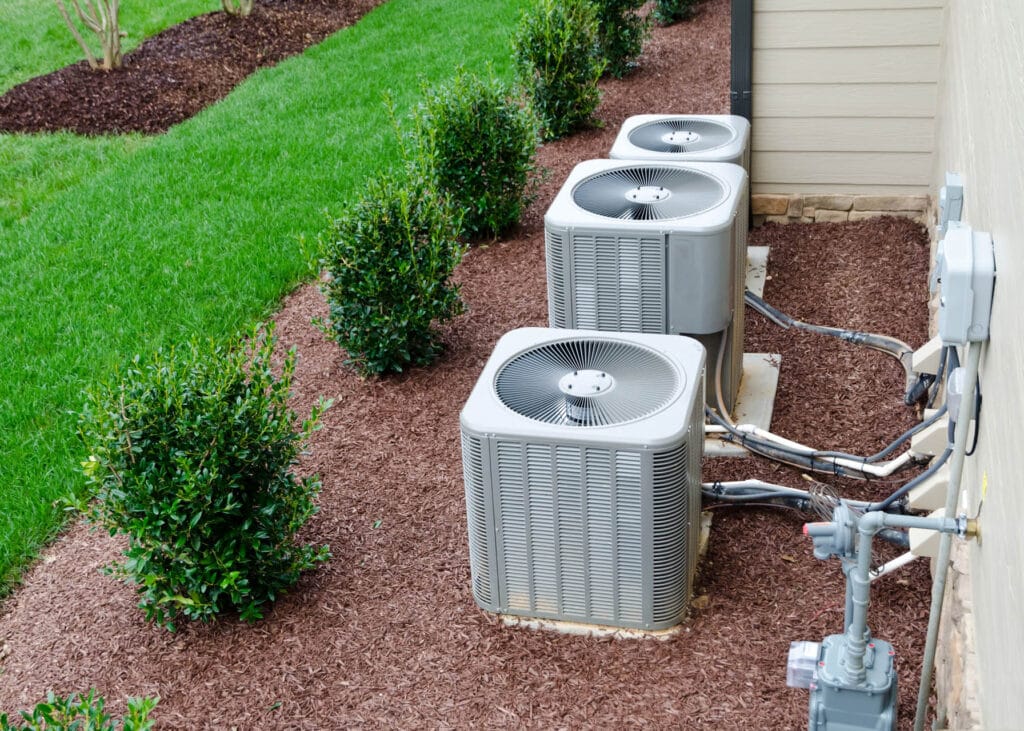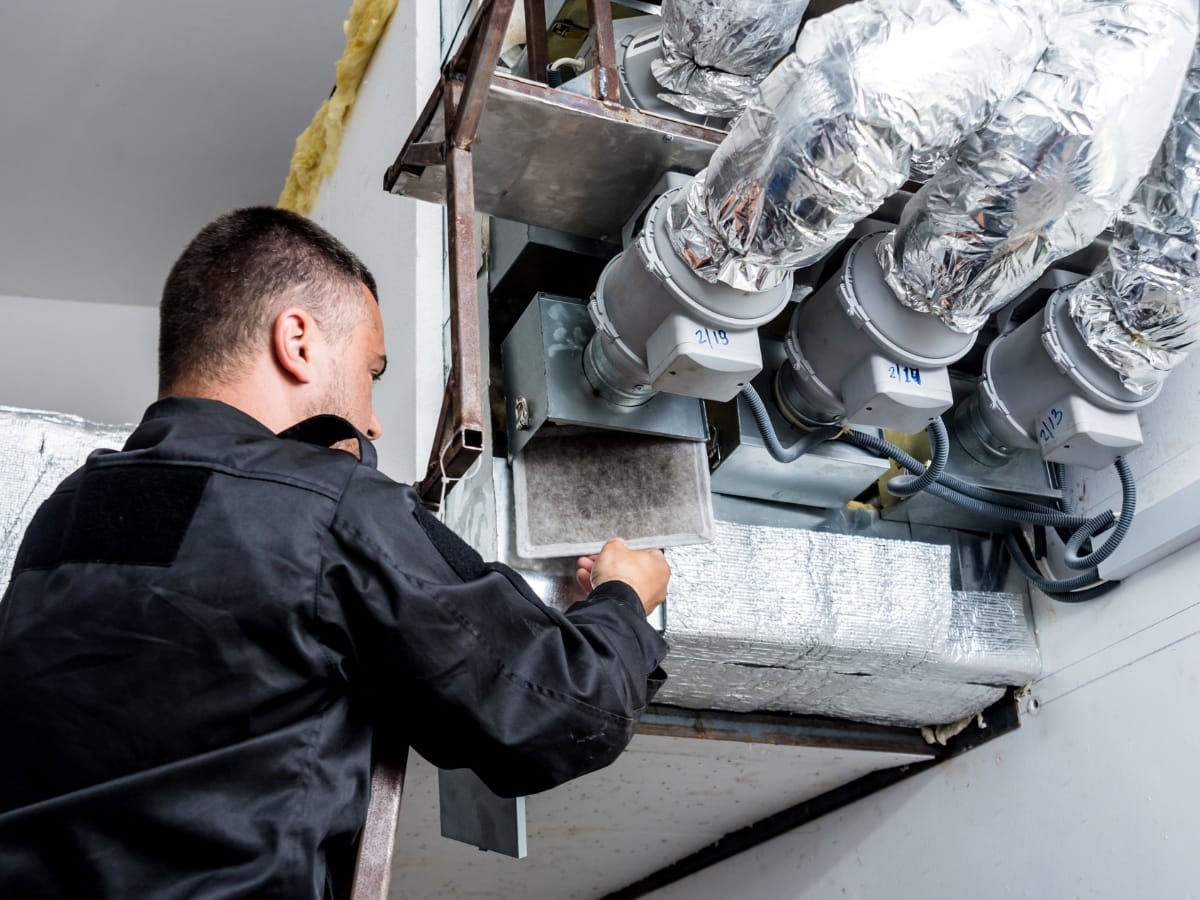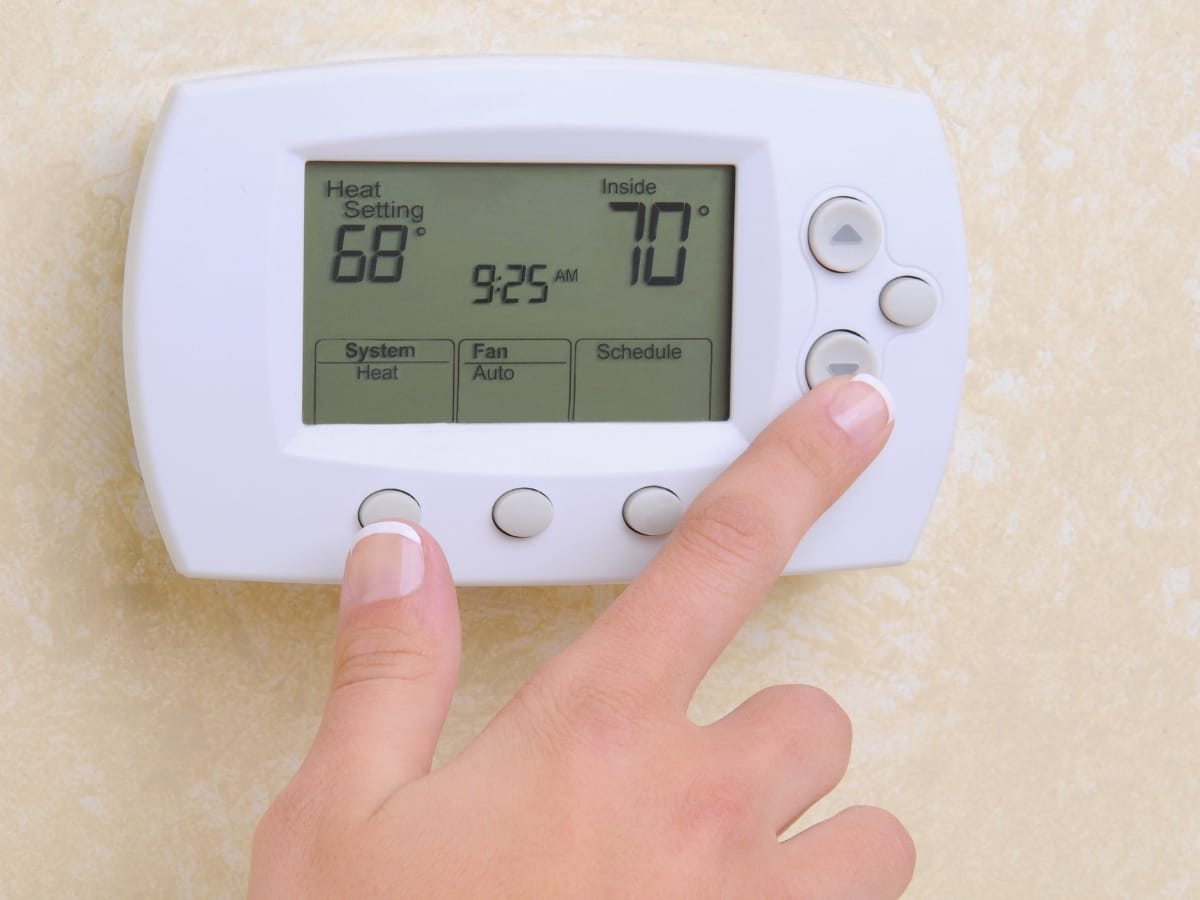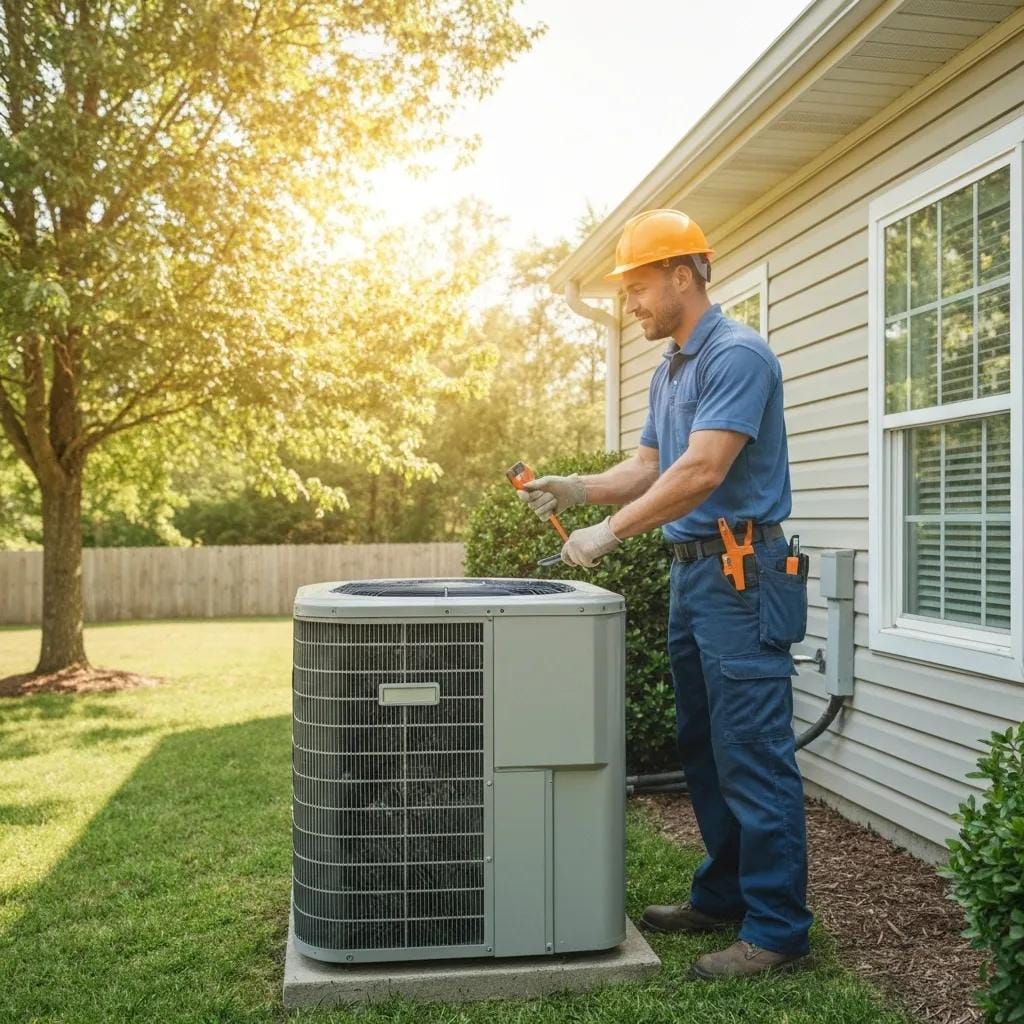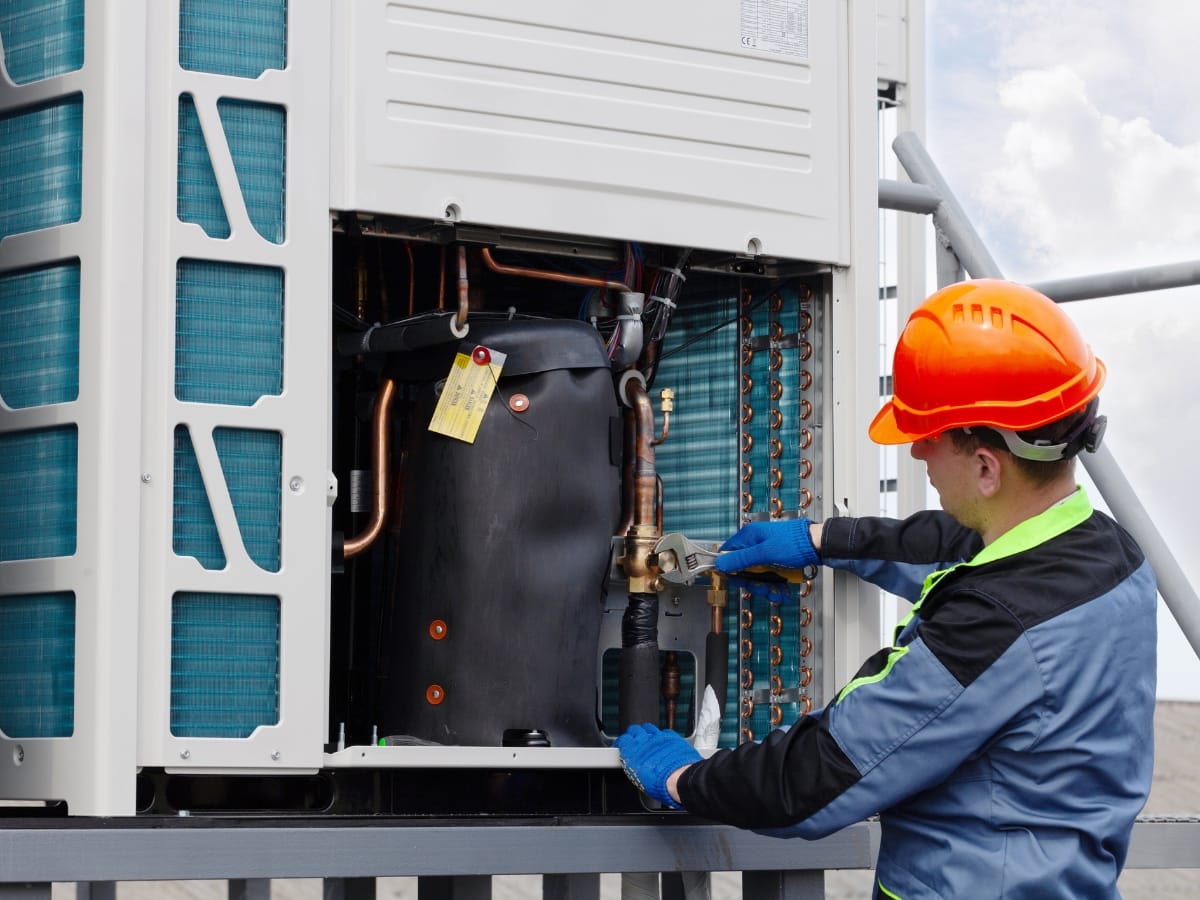Ductless HVAC systems, also known as mini-splits, offer a flexible and energy-efficient alternative to traditional central heating and cooling. These systems are particularly appealing for homeowners looking to avoid the energy loss associated with ductwork or those needing targeted temperature control in specific areas of their home. While mini-splits provide advantages like easy installation, zoning capabilities, and improved efficiency, they also come with potential drawbacks, including higher upfront costs and aesthetic considerations. In this guide, we’ll explore the key pros and cons of ductless HVAC systems to help you decide if a mini-split is the right choice for your home.
Small Space? Big Comfort? Go Ductless HVAC
What Are Ductless HVAC and Mini-Split Systems?

Ductless HVAC, commonly called mini-splits, offers both heating and cooling without the need for traditional ductwork. Each system pairs an outdoor compressor/condenser with one or more indoor air-handling units. These components connect through insulated refrigerant lines, allowing each indoor unit to control temperature independently. By avoiding duct losses, mini-splits deliver more precise comfort and higher energy efficiency than many central systems.
How Mini-Split Systems Operate Without Ducts
In cooling mode, the outdoor unit compresses refrigerant into a hot, high-pressure gas. This gas travels indoors and expands in the evaporator coil of the air handler, absorbing heat from room air. A fan then circulates cooled air back into the space.
The refrigerant, now a low-pressure gas, returns outside, releases its absorbed heat through the condenser coil, and repeats the cycle. When switched to heating, the process reverses: heat is drawn from outdoor air and delivered inside. Because mini-splits use inverter-driven compressors that adjust speed to match demand, they avoid the start-stop cycling of conventional units, maintaining stable temperatures and conserving energy.
Key Components of a Ductless HVAC System
A complete ductless system includes the outdoor compressor/condenser, indoor air handlers, connecting refrigerant lines, and a control interface. The outdoor unit contains the compressor and condenser coil, while each indoor unit houses an evaporator coil and blower fan. Insulated copper lines carry refrigerant between these units, and a drain line removes condensate.
Control signals travel over a thin cable or via wireless communication, allowing users to adjust temperature, fan speed, and mode through a remote or wall-mounted thermostat. High-quality installations also include a line-set cover for aesthetics and additional sealing to prevent moisture intrusion.
Reliable Mini-Split Brands for Georgia Homes
Several manufacturers lead the mini-split market with proven reliability and performance suited to Georgia’s climate. Mitsubishi Electric systems are recognized for maintaining capacity in extreme temperatures and offering whisper-quiet indoor units. Fujitsu models stand out for their high seasonal efficiency ratings and unobtrusive operation, making them popular for residential bedrooms and living spaces.
Daikin combines robust inverter technology with smart-home integration, allowing remote monitoring and scheduling via mobile apps. When selecting a brand, look for Energy Star certification and favorable SEER and HSPF ratings to ensure lower operating costs and eligibility for potential rebates.
Advantages of Ductless Mini-Split HVAC Systems

Ductless mini-split systems eliminate the energy losses associated with leaky or poorly insulated ductwork found in many older central HVAC installations. Without long runs of air ducts, conditioned air reaches rooms directly, saving up to 30 percent in energy compared to conventional systems. Each indoor unit can be set to its own temperature, so you only cool or heat the spaces you use. This targeted approach reduces overall energy consumption and lowers utility bills. Installation is also less invasive: mounting a wall or ceiling unit and running a single, small refrigerant line through the wall disrupts living spaces far less than adding or extending ductwork. As a result, mini-splits work well in historic properties, room additions, or any setting where building new ducts would be difficult or costly.
Energy Efficiency Through Inverter Technology
Mini-splits employ inverter-driven compressors that adjust output continuously to match current heating or cooling demand. Instead of the full-power on/off cycling of traditional systems, these compressors ramp up or down smoothly. This precise modulation keeps temperatures stable and eliminates the energy spikes that occur when systems restart. By operating at lower power for longer periods, inverter technology reduces both electricity use and wear on components. Over a cooling season, homeowners often see noticeable savings on their energy bills, making mini-splits an attractive investment for both new construction and retrofit projects.
Customized Zoning for Maximum Comfort
Each indoor air handler in a mini-split system functions independently, allowing multiple zones—bedrooms, living areas, offices—to be set at different temperatures. In a multi-story home, for example, bedrooms upstairs can be kept cooler at night without over-cooling the ground floor. In a home office, you can maintain a comfortable work environment without running the central system for the entire house. This individualized control prevents wasted conditioning in unoccupied areas and gives everyone in the household the ability to adjust their own comfort settings.
Simplified, Non-Invasive Installation
Installing a mini-split generally requires only a three-inch hole in an exterior wall for the refrigerant lines, power cable, and condensate drain. Indoor units mount on the wall or ceiling and connect to an outdoor condensing unit via insulated tubing and wiring. Without ductwork, labor time and material costs are significantly lower. Existing homes benefit especially, as there’s no need to cut into walls and ceilings to run ducts. The streamlined installation also means less disturbance to furniture, flooring, and finishes, accelerating project completion and minimizing cleanup.
Improved Indoor Air Quality
Because there are no ducts to accumulate dust, pollen, or mold, ductless systems deliver cleaner air directly to living spaces. Most mini-split units include multi-stage air filters—such as washable mesh filters and optional HEPA or carbon layers—that capture fine particles and reduce odors. Some models offer built-in dehumidification, lowering humidity levels without overcooling the air. The result is a healthier indoor environment ideal for allergy sufferers or anyone sensitive to airborne contaminants. Regular filter cleaning and occasional technician check-ups ensure that the system continues to provide fresh, well-conditioned air season after season.
Common Drawbacks and Limitations of Mini-Split Systems
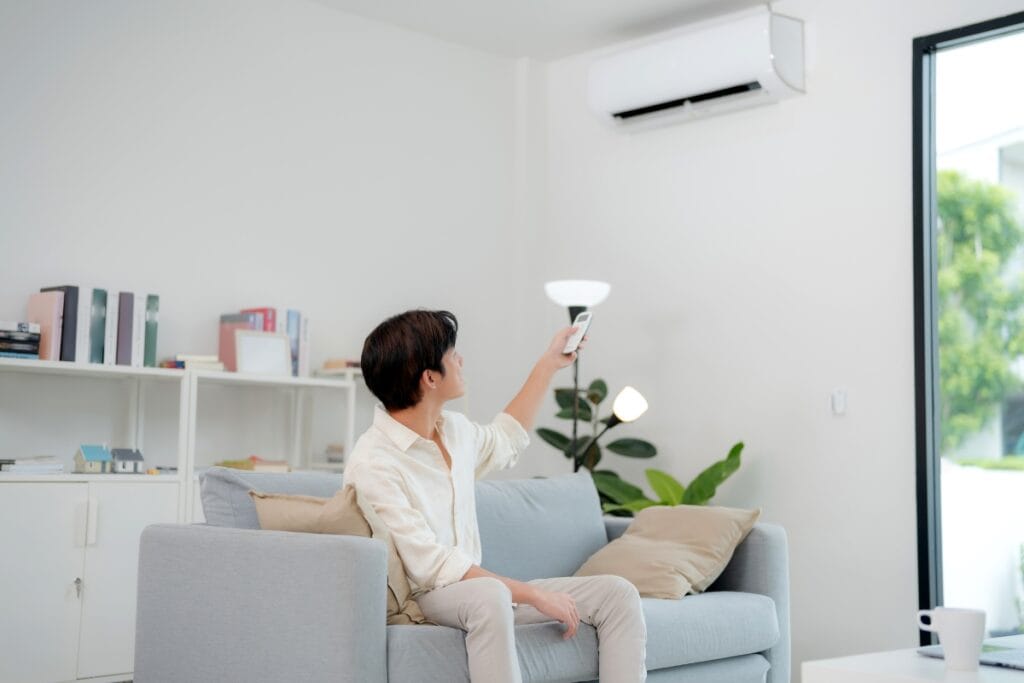
While ductless mini-split HVAC systems offer many advantages, they are not without shortcomings. One of the most noticeable is the upfront cost. Mini-splits tend to be more expensive initially than conventional central systems because each zone requires its own indoor air handler, refrigerant lines, and wiring to the outdoor compressor. For a large home, equipping multiple rooms can drive up equipment and installation expenses.
Additionally, cooling or heating very large, open spaces may require installing several indoor units to ensure even temperature distribution, which adds complexity to both design and control. Finally, the appearance of wall-mounted indoor units may not blend seamlessly with every interior style. Although today’s models are slimmer and more visually refined, homeowners seeking a completely hidden solution sometimes need to consider ceiling-cassette units or custom enclosures, which can further increase costs.
Upfront Cost Versus Long-Term Savings
The higher purchase price of mini-splits reflects their advanced inverter-driven compressors, individual zone controls, and lack of ductwork. Installing a new ducted system often involves constructing or modifying duct runs, which can be labor-intensive and disruptive.
In comparison, mini-splits only require small openings for refrigerant and electrical lines, reducing remodel impact. Although the initial outlay is greater, the systems typically deliver excellent energy efficiency—often surpassing 20 SEER ratings—thanks to precise modulation of compressor speed and the elimination of duct losses that can exceed 20 percent in older homes.
Over several years, reduced electricity bills and fewer maintenance issues tied to duct cleaning can offset the original investment. Homeowners should run a life-cycle cost analysis, comparing upfront expenses against projected energy and maintenance savings, to determine which option delivers the best value in their specific situation.
What Maintenance and Repair Issues Should Owners Expect?
Mini-splits require regular filter cleaning—about once a month in high-use seasons—and periodic inspection of outdoor coils, refrigerant lines, and condensate drains. Failure to clear filters or obstruct condensate pathways can reduce airflow, degrade efficiency, and increase wear on components. Unlike central systems, where a single air handler services the entire home, each indoor unit in a mini-split system represents a separate maintenance point.
Professional servicing is generally necessary for refrigerant checks, system diagnostics, or compressor issues, since these units use specialized refrigerant circuits and electronic controls. Repairs on multi-zone installations may be more expensive because a licensed technician must test and service each individual unit. To maximize reliability and avoid costly emergency repairs, owners should schedule annual tune-ups with a qualified HVAC contractor familiar with mini-split technology.
Aesthetic and Integration Challenges
The visible nature of wall-mounted air handlers can conflict with certain design schemes. While manufacturers have slimmed down profiles and introduced neutral color options, the units still occupy wall space and may draw attention in minimalist or traditional interiors. To address this, some homeowners install ceiling-cassette models that recess into drop ceilings or use decorative cabinets to conceal indoor units.
These solutions preserve comfort and efficiency while minimizing visual impact, but they can add to installation complexity and cost. For those who prefer a completely seamless look, the additional expense of custom enclosures or advanced installation methods should be weighed against the benefits of localized temperature control and the absence of ductwork.
Choosing the Right Ductless HVAC System for Your Home or Business

Selecting a ductless mini-split system involves more than picking the most powerful model. To achieve reliable comfort and efficient operation, you need to match system performance to your space’s specific needs. Start by evaluating the square footage, ceiling height, insulation quality, and window locations in each zone you plan to condition. Proper sizing prevents inefficiencies such as short-cycling, which can shorten equipment life, or under-sizing, which leaves areas inadequately cooled or heated.
Determining BTU Requirements Through Heat Load Calculations
Each indoor unit’s capacity is measured in British Thermal Units per hour (BTU/h). To calculate the right BTU rating, contractors consider room dimensions, the number of occupants, heat-generating appliances, and exposure to sunlight. Well-insulated spaces with double-pane windows require fewer BTUs than a poorly insulated sunroom. Professional HVAC specialists use standardized heat load formulas, often supplemented by software, to ensure each zone receives just enough capacity to maintain desired temperatures without wasting energy on oversized equipment.
Comparing SEER Ratings and Overall Energy Performance
Seasonal Energy Efficiency Ratio (SEER) indicates how efficiently a cooling system runs over an entire season. Models rated at 20 SEER or above significantly outpace older, ducted systems and even many conventional mini-splits. Beyond SEER, inverter-driven compressors offer variable-speed operation, minimizing the energy spikes associated with on/off cycling.
Some manufacturers publish HSPF (Heating Seasonal Performance Factor) for heat pump efficiency in heating mode. Smart controls—such as programmable thermostats and humidity sensors—further reduce consumption by adjusting output to actual indoor conditions. When researching models, compare these efficiency metrics alongside real-world user reviews that report on seasonal energy bills.
Key Features to Prioritize in a Mini-Split System
Reliable inverter compressors form the heart of a mini-split’s performance. Look for proven brands that maintain capacity even in extreme outdoor temperatures. Indoor unit noise levels—measured in decibels—vary widely; quieter units operate below 30 dB, making them suitable for bedrooms and offices. Advanced air filtration systems, including multi-stage and HEPA options, remove dust, pollen, and microbial particles to improve indoor air quality. Remote control features let you adjust temperature, fan speed, and scheduling from a wall-mounted interface or via a smartphone app. Systems that integrate with home automation platforms or voice assistants can further streamline daily use. Finally, examine warranty coverage on compressors, coils, and electronics, as well as the availability of authorized service technicians in your area.
What Does Professional Installation and Maintenance of Mini-Splits Involve?
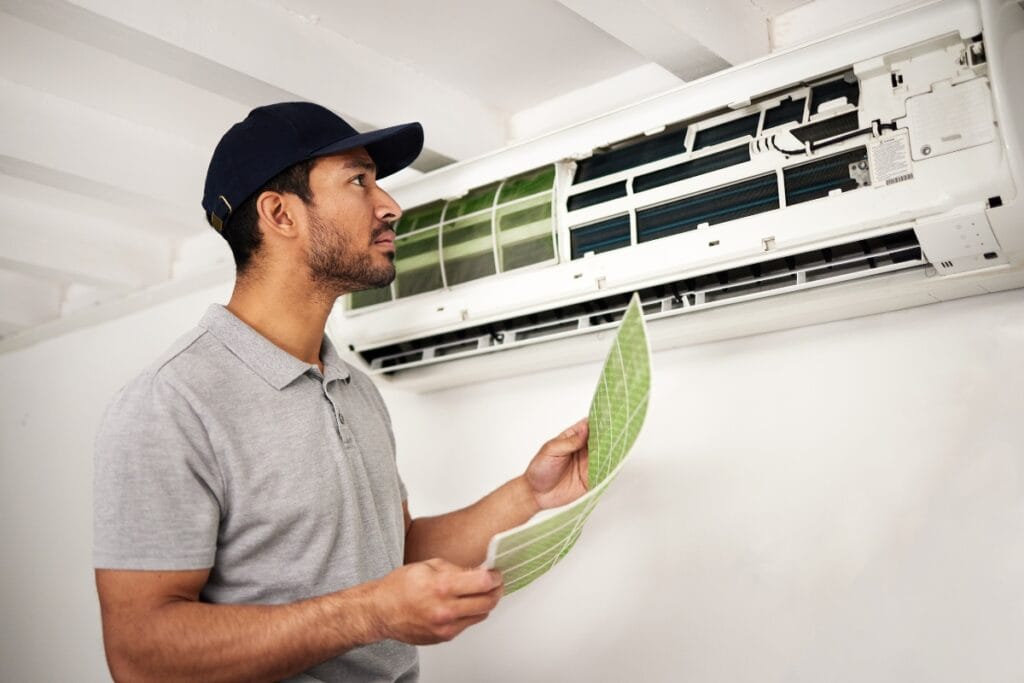
Ensuring that a ductless mini-split system runs efficiently starts with expert installation and continues with regular servicing. Trained technicians handle everything from load calculations to system checks, guaranteeing optimal performance and extending the equipment’s lifespan.
Why Is Expert Installation Important for Ductless HVAC Systems?
Correct installation sets the foundation for reliable operation. Certified installers size the system to match each room’s cooling and heating requirements, place indoor units for even airflow, and route refrigerant lines to minimize heat gain or loss. They also install a dedicated electrical circuit and weatherproof disconnects to protect against shorts and moisture intrusion. Precise refrigerant charging and evacuation of air and water vapor prevent compressor damage and maintain rated efficiency.
Key Steps in a Typical Mini-Split Installation
A professional installation follows a step-by-step process:
- Load Assessment and System Selection: Technicians measure room dimensions, ceiling heights, insulation levels, window orientation, and occupancy to calculate BTU requirements. This ensures the chosen system neither struggles nor short-cycles.
- Indoor Unit Placement: Air handlers are mounted on walls or ceilings in locations that avoid direct sunlight, drafts, or obstructions. Proper positioning maximizes coverage and minimizes cold or hot spots.
- Outdoor Unit Installation: The compressor/condenser is placed on a stable pad or wall bracket with sufficient clearance for airflow and maintenance. Anti-vibration mounts reduce noise and extend component life.
- Line-Set and Wiring Installation: A small wall opening accommodates insulated refrigerant tubing, condensate drain lines, and low-voltage control wiring. Lines are routed to minimize bends and insulated to prevent energy loss.
- Electrical Connections and Refrigerant Charging: Installers tie the system into its own circuit breaker, ensuring correct wire gauge and grounding. After leak testing, the refrigerant lines are evacuated, then charged with the precise amount of refrigerant specified by the manufacturer.
- System Testing and Homeowner Orientation: Technicians verify communication between indoor and outdoor units, measure temperature differentials, and check airflow. They also demonstrate controls, filter cleaning, and basic troubleshooting.
Routine Maintenance for Long-Term Reliability
Scheduling annual service—ideally before peak cooling or heating seasons—keeps mini-splits operating at full capacity. Maintenance tasks include:
- Filter Cleaning and Replacement: Removing dust and debris from washable filters maintains airflow and indoor air quality. Disposable filters are replaced as needed.
- Coil and Condensate Drain Inspections: Technicians clean evaporator and condenser coils to prevent efficiency losses and clear drain lines to avoid water backups.
- Electrical and Refrigerant Checks: Connections are tightened and inspected for corrosion, while refrigerant pressures are measured and adjusted to manufacturer specifications.
- System Diagnostics: Error codes, unusual noises, and airflow readings are evaluated to catch wear or impending faults before they cause breakdowns.
In dustier or pet-friendly environments, semiannual checks may be advisable to address faster buildup. Detailed service reports help homeowners track maintenance history and plan future upkeep.
How Do Ductless Mini-Splits Compare to Traditional HVAC Systems?
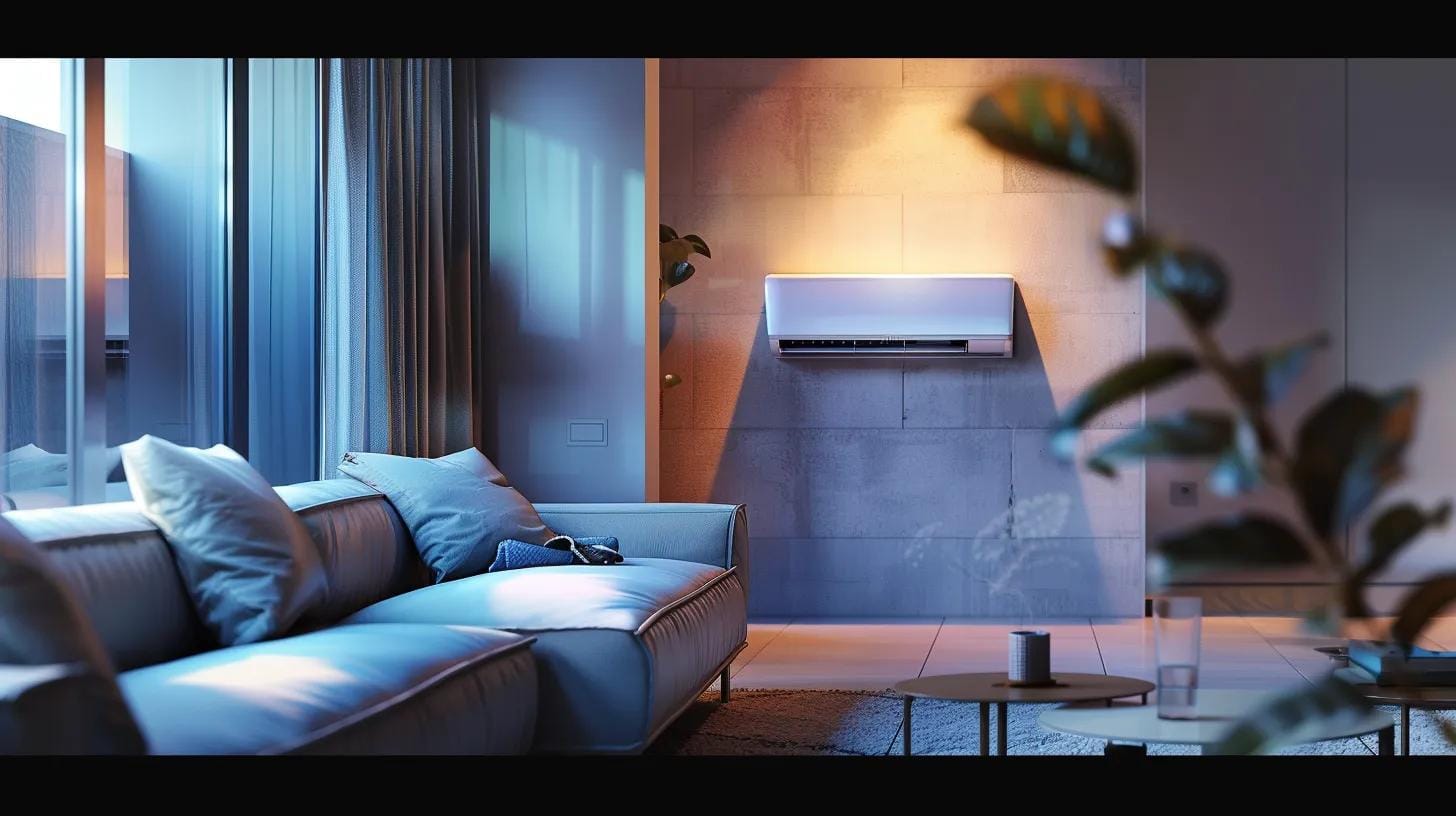
Ductless mini-split systems and conventional central HVAC each bring distinct advantages. Mini-splits deliver conditioned air directly into rooms through wall- or ceiling-mounted units, eliminating the energy losses and maintenance challenges associated with ductwork. Central systems, by contrast, circulate air through a network of ducts, offering a single point of temperature control that many homeowners find straightforward. While central units often cost less up front per ton of capacity, mini-splits recoup their higher initial price through lower operating expenses and reduced installation disruption, especially in homes without existing ducts or in room additions.
Energy Efficiency and Operating Costs
The absence of ducts gives mini-splits a clear edge in efficiency. In a traditional system, as much as 25 percent of the cooled or heated air can escape through leaks or gaps in poorly sealed ducts. Mini-splits avoid this waste by moving refrigerant rather than air through insulation-challenged walls, resulting in less energy consumed for the same level of comfort. Inverter-driven compressors further boost savings: instead of cycling on and off at full power, they vary their speed to match actual demand, maintaining steady temperatures without the energy spikes of conventional units. Over a single cooling season, these gains can translate into tens or hundreds of dollars saved on electricity bills, making mini-splits cost-effective over their lifespan.
Installation Costs and Complexity
Installing a traditional HVAC system requires running ductwork through ceilings, walls, or crawlspaces. This process can be invasive, time-consuming, and expensive—particularly in retrofits where new ducts must be carved through finished spaces. Ductless mini-splits simplify installation by only needing a small hole—typically three inches—for refrigerant lines, drain tubing, and power cables. Indoor units mount directly on walls or ceilings, and the outdoor compressor sits on a pad or bracket. While the equipment cost per ton of cooling is often higher for mini-splits, labor costs are generally lower due to the streamlined installation. The result is a faster turnaround with less impact on existing finishes.
Zoning and Comfort Control
One of the most compelling advantages of mini-splits is individualized zoning. Each indoor unit operates independently, allowing occupants to set unique temperatures in bedrooms, living rooms, offices, or guest suites. This granular control avoids conditioning empty or lightly used areas, further reducing energy use. Traditional systems, in contrast, rely on a single thermostat that governs the entire duct network. While zoning dampers can segment a central system, they add complexity and cost and often fail to deliver the same precision. For multi-story homes or spaces with varying sun exposure, mini-splits provide a level of comfort customization that central HVAC struggles to match.
Maintenance and Longevity
Central HVAC systems require periodic duct cleaning to maintain indoor air quality and efficiency, along with regular servicing of blowers and coils. Mini-splits simplify upkeep: homeowners clean or replace filters in each indoor unit and have technicians inspect coils, refrigerant levels, and drain lines annually. The lack of ducts means fewer places for mold, dust, or allergens to accumulate, enhancing air quality. Both systems have comparable lifespans for outdoor compressors—typically 15 to 20 years—but mini-splits may outlast central systems by avoiding corrosion and leaks in ductwork.
Ultimately, the choice between ductless and ducted HVAC hinges on a home’s layout, occupants’ comfort preferences, and long-term operating budget. By weighing installation impacts, energy savings, and control requirements, homeowners can select the system that best fits their needs.
Frequently Asked Questions
Q: What size mini-split systemdo I need for my home? A: The required size depends on the square footage, insulation quality, number of windows, and overall heat load. Professional HVAC contractors can perform a detailed load analysis to determine the correct BTU capacity for optimal performance.
Q: How does the inverter technology in mini-splits improve efficiency? A: Inverter technology enables the system to adjust power output based on actual cooling or heating demands, reducing the on-off cycling seen in traditional systems. This results in lower energy consumption and a longer lifespan for the unit while maintaining a consistent indoor temperature.
Q: Are there any government incentives or rebates available for mini-split installations? A: Many regions offer tax credits and rebates for the installation of energy-efficient HVAC systems, including mini-splits. Homeowners in Metro Atlanta should consult local energy authorities and utility providers to determine eligibility and take advantage of these financial incentives.
Q: How does regular maintenance impact the performance of a mini-split system? A: Regular maintenance, including cleaning filters and periodic professional inspections, is essential for efficient operation. It ensures optimized airflow and refrigerant levels, helping to maintain peak performance and preventing costly breakdowns.
Q: Can mini-splits be used for both heating and cooling in extreme weather conditions? A: Yes. Mini-splits are engineered for dual functionality. Advanced models with heat pump technology perform effectively in both very cold and very hot weather, though performance will vary with unit specifications and local climate.
Q: What makes ductless systems a better option for retrofitting older homes? A: Retrofitting traditional ductwork can be invasive and costly. Ductless mini-split systems require only small openings for refrigerant lines, making them easier and less disruptive to install in historic or older homes, preserving architectural features while enhancing climate control.
Q: How do mini-split systems contribute to improved indoor air quality? A: By eliminating ductwork, mini-splits avoid the accumulation of dust and allergens that commonly affect central HVAC systems. Many units include advanced filters that trap airborne particles, resulting in cleaner, healthier indoor air.
Final Thoughts
Ductless mini-splits offer unparalleled flexibility, energy savings, and precise temperature control—making them an ideal choice for everything from room additions to whole-home comfort upgrades. While installation costs and upfront equipment investment can be higher than traditional systems, the long-term efficiency gains and zoning capabilities often pay dividends in reduced energy bills and enhanced living spaces. If you’re considering a ductless HVAC solution, trust Ace Tech Heating & Cooling to guide you through the pros and cons and deliver a system tailored to your needs. Give us a call at (404) 369-9100 or fill out our online form for a free quote today—your comfortable, efficient home is just a click or call away!


